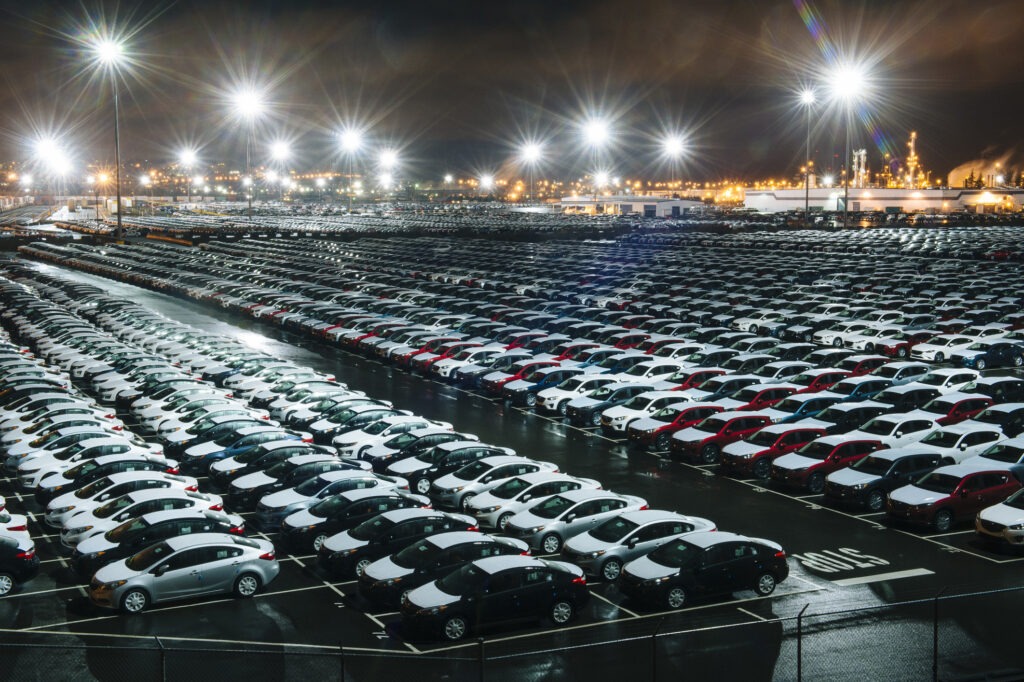UK new-LCV market enjoys best February in 26 years
18 March 2024

The UK’s new-LCV market grew in February as levels of used stock increased. Andy Picton, chief commercial vehicle editor at Glass’s (now part of J.D. Power), examines the figures with Autovista24 editor Tom Geggus.
Registrations in the UK’s new light-commercial vehicle (LCV) market grew for a 14th straight month in February, with volumes rising 2.2%. A total of 17,934 new vehicles took to the country’s roads, the best result for the period in 26 years. This was after 18,044 units were registered in February 1998. However, there were mixed performances across the different sectors.
Pickups recorded a 21.2% increase in registrations. Meanwhile, vans between 2.5-3.5 tonnes gross-vehicle weight (GVW) saw deliveries rise by 1.4%, representing over 68% of the new-LCV market. Vans weighing below two tonnes and those between 2-2.5 tonnes GVW recorded drops of 20.5% and 5.9% respectively.
Ford Transit on top
Ford recorded another strong month, with the Transit (1,838 units) in first. The Transit Custom (1,611 units) came second, the Ranger pickup (741 units) seventh and the Transit Connect (578 units) 10th. Meanwhile, the Mercedes-Benz Sprinter (1,325 units) finished in third.
From Stellantis, the Vauxhall Vivaro (1,173 units), Citroen Berlingo (701 units) and the Citroen Dispatch (626 units) came fourth, eighth and ninth respectively. The Toyota Hilux (836 units) finished fifth while the Maxus Deliver 9 (779 units) claimed sixth.
Electric market down
A total of 847 all-electric LCVs, up to 3.5 tonnes GVW, were registered in February. This represented a 12.3% drop on the same month in 2023. The powertrain’s LCV market share hit 4.7%, down from 5.5% twelve months ago. This puts the 2024 year-to-date share at 4.9%.
Maintaining incentives, alongside the installation of van-dedicated chargers and a levelling of charging costs, is vital for attracting fleets to the technology. Without these measures, achieving the upcoming zero-emission vehicle (ZEV) mandate requirements will be beyond difficult.
February saw Vauxhall regain first place in the electric-van market. The brand recorded 179 registrations, taking a 19.6% share of the EV market. This put it ahead of Ford with 143 units (15.7% share) and Toyota with 127 deliveries (13.9% share).
Both the Vauxhall Vivaro Electric and the Toyota Proace City Electric registered 120 units in February. The Volkswagen (VW) ID.Buzz Cargo was third with 95 units, followed by the fourth-place Ford E-Transit with 86 units and the Citroen eBerlingo in fifth with 64 units.
Who met the mandate?
With the zero-emission vehicle (ZEV) mandate applying to manufacturers from the start of 2024, 10% of total deliveries by the end of the year must be made up of BEVs and hydrogen models. With the latter technology still very much in its infancy, all-electric LCVs will be required to meet the target.
In the year to date, BYD delivered only electric LCVs, however, this was only four units in total. Then came Peugeot (9.7%), Renault (8.8%), Volkswagen (8.6%) and Nissan (8.3%).
Additionally, 64 all-electric vehicles weighing above 3.5 tonnes GVW were registered in February. Thi put the month’s all-electric total at 911 units.
February also saw the government reverse an earlier decision on the taxation of double-cab pick-ups with a payload of one tonne or more. Now, with these pick-ups confirmed as commercial vehicles, growth in the sector looks set to continue.
Manufacturers have zero-emission pick-ups in the pipeline, with many due to enter production in the next few years. With increasing annual targets, brands need all the assistance possible if they are to achieve the goals set out by the ZEV mandate.
Used confidence grows
Confidence in the used-LCV market has grown since the start of the year, with good levels of stock availability and plenty more to come. Much of this stock is coming from rental, fleet, lease and contract hire sources.
Much of this volume was duplicated, low spec, in white and with varying degrees of damage, wear and tear. With buyers competing to secure the best stock available, the condition of these vehicles is key if they are to attract the best prices possible.
Transactions of LCVs dropped by 1.1% in February compared with January. Three-quarters of all sales at auction were Euro 6 models, with an average age of 54.4 months. The average mileage was just under 73,400 miles. Meanwhile, the average selling price was just over £10,000.
All-electric vans made up nearly 2% of all used sales at auction, with an average age of 85.4 months. Their average mileage sat at nearly 52,500 miles, with the average selling price at £4,900. Euro 5 stock made up the remaining 22% of sales.
Sales volume falls
The volume of sales decreased by 1.1% in February. The average price fell by 1.4% over the same period and was down 13.3% on the same point last year. Meanwhile, the average age of vehicles sold fell slightly, from 78 months to 77.3 months, and down 4.9 months year on year. The average mileage fell by 1.4% to 80,938 miles. This was 3.9% lower than January 2023.
More medium vans were sold at auction than any other vehicle type, accounting for nearly 35.3% of all sales. Large vans accounted for 26.8% and small vans 26.2%. Volumes of 4x4 stock accounted for only 11.6% of all sales but attracted the strongest average prices of £13,098, up by £609 on January.
Large vans covered more distance than any other body type at an average of 91,920 miles. This was down 900 miles on January and over 2,200 miles less than in February 2023.
First-time conversion rates for February increased to 78.8% from 75.9% in January. Broken down, the best conversion rates were recorded in the small-panel van sector at 82.3%, while the 4x4 pickup sector returned the lowest conversion rate of 75.1%.
The number of used LCVs observed for sale on the wholesale market increased by 1.3% in February to just over 43,100 units. A total of 43.3% of all vehicles on sale were valued at £20,000 or more, while 37.1% were advertised for sale between £20,000 and £10,000.
At the lower end of the market, those vehicles on sale for between £10,000 to £5,000 accounted for 15.5% of the market, while 4.1% were on sale for less than £5,000.



